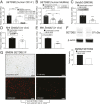Coronavirus induces diabetic macrophage-mediated inflammation via SETDB2
- PMID: 34479991
- PMCID: PMC8463849
- DOI: 10.1073/pnas.2101071118
Coronavirus induces diabetic macrophage-mediated inflammation via SETDB2
Abstract
COVID-19 induces a robust, extended inflammatory "cytokine storm" that contributes to an increased morbidity and mortality, particularly in patients with type 2 diabetes (T2D). Macrophages are a key innate immune cell population responsible for the cytokine storm that has been shown, in T2D, to promote excess inflammation in response to infection. Using peripheral monocytes and sera from human patients with severe acute respiratory syndrome coronavirus 2 (SARS-CoV-2), and a murine hepatitis coronavirus (MHV-A59) (an established murine model of SARS), we identified that coronavirus induces an increased Mφ-mediated inflammatory response due to a coronavirus-induced decrease in the histone methyltransferase, SETDB2. This decrease in SETDB2 upon coronavirus infection results in a decrease of the repressive trimethylation of histone 3 lysine 9 (H3K9me3) at NFkB binding sites on inflammatory gene promoters, effectively increasing inflammation. Mφs isolated from mice with a myeloid-specific deletion of SETDB2 displayed increased pathologic inflammation following coronavirus infection. Further, IFNβ directly regulates SETDB2 in Mφs via JaK1/STAT3 signaling, as blockade of this pathway altered SETDB2 and the inflammatory response to coronavirus infection. Importantly, we also found that loss of SETDB2 mediates an increased inflammatory response in diabetic Mϕs in response to coronavirus infection. Treatment of coronavirus-infected diabetic Mφs with IFNβ reversed the inflammatory cytokine production via up-regulation of SETDB2/H3K9me3 on inflammatory gene promoters. Together, these results describe a potential mechanism for the increased Mφ-mediated cytokine storm in patients with T2D in response to COVID-19 and suggest that therapeutic targeting of the IFNβ/SETDB2 axis in T2D patients may decrease pathologic inflammation associated with COVID-19.
Keywords: coronavirus; diabetes; epigenetics; inflammation; monocyte/macrophage.
Copyright © 2021 the Author(s). Published by PNAS.
Conflict of interest statement
The authors declare no competing interest.
Figures







References
Publication types
MeSH terms
Substances
Grants and funding
- T32 HL007853/HL/NHLBI NIH HHS/United States
- R01 HL137919/HL/NHLBI NIH HHS/United States
- F32 DK126471/DK/NIDDK NIH HHS/United States
- F32 DK117545/DK/NIDDK NIH HHS/United States
- P30 DK020572/DK/NIDDK NIH HHS/United States
- R01 DK124290/DK/NIDDK NIH HHS/United States
- F32 HL152508/HL/NHLBI NIH HHS/United States
- R01 DK127531/DK/NIDDK NIH HHS/United States
- R01 HL15627401/NH/NIH HHS/United States
- R01 HL156274/HL/NHLBI NIH HHS/United States
- R35 HL144481/HL/NHLBI NIH HHS/United States
- R01 AR079863/AR/NIAMS NIH HHS/United States
LinkOut - more resources
Full Text Sources
Medical
Molecular Biology Databases
Research Materials
Miscellaneous

